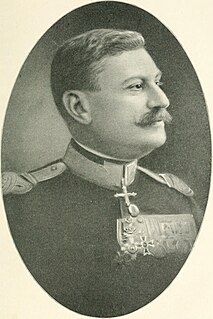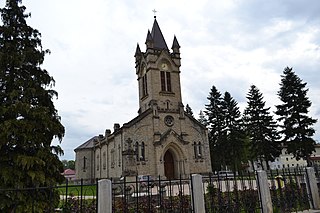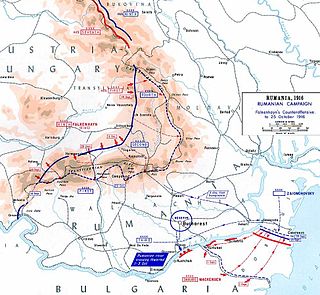The 1st Army was a field army-level command in the ground forces of Austria-Hungary during World War I. The army fought in Galicia and Russian Poland in 1914–15 before being briefly dissolved in the summer of 1916. Shortly afterwards, it was reformed and sent to fight in the Romanian Campaign for the next two years. The 1st Army was demobilized in April 1918 due to its heavy losses, following Romania's surrender.

The Battle of Mărășești was the last major battle between the German Empire and the Kingdom of Romania on the Romanian front during World War I. Romania was mostly occupied by the Central Powers, but the Battle of Mărășești kept the northern region of the country free from occupation.

The Kingdom of Romania was neutral for the first two years of World War I, entering on the side of the Allied powers from 27 August 1916 until Central Power occupation led to the Treaty of Bucharest in May 1918, before reentering the war on 10 November 1918. It had the most significant oil fields in Europe, and Germany eagerly bought its petroleum, as well as food exports.

The Order of Michael the Brave is Romania's highest military decoration, instituted by King Ferdinand I during the early stages of the Romanian Campaign of the First World War, and was again awarded in the Second World War. The Order, which may be bestowed either on an individual or on a whole unit, was named in honor of Michael the Brave, the late 16th-century Prince of Wallachia, Transylvania, and Moldavia.

The Monument to the Heroes of the Engineer Arm in Bucharest, Romania is dedicated to the heroism and sacrifice of the military engineers who fought in the Romanian Army during World War I, of whom nearly a thousand were killed in action and many more wounded.

Eremia Teofil Grigorescu was a Romanian artillery general during World War I, and Minister of War in the Constantin Coandă cabinet.

Oituz is a commune in Bacău County, Western Moldavia, Romania. It is composed of six villages: Călcâi (Zöldlonka), Ferestrău-Oituz (Fűrészfalva), Hârja (Herzsa), Marginea, Oituz and Poiana Sărată (Sósmező).

Dumitru Carlaonț was a Romanian major-general during World War II, who is known for being imprisoned and acquitted for war crimes three times. He was the younger brother of General Ioan Carlaonț.
The Third Battle of Oituz was a confrontation between Romanian and, to a lesser extent, Russian forces on one side and German and Austro-Hungarian forces on the other, during the Romanian Campaign of World War I. The battle took place primarily in the Oituz valley on the border between Hungary and Romania, from 8 to 22 August 1917.
The Second Army was a field army of the Romanian Land Forces, created on 18 August 1916.

The Armistice of Focșani was an agreement that ended the hostilities between Romania and the Central Powers in World War I. It was signed on 9 December 1917 in Focșani in Romania.

Gheorghe D. Mărdărescu was a Romanian army major general during World War I, a commander during the Hungarian–Romanian War of 1919, and Minister of War from 1922 to 1926.

The Battle of the Southern Carpathians was a major operation during the Romanian Campaign of World War I. The brainchild of German General Erich von Falkenhayn, the operation consisted in an attempt by the Central Powers to assault all of the passes in the Southern Carpathians at the same time, and exploit a success wherever it might have come. However, this did not happen, as Romanian defenses could not be defeated in any of the five areas that Falkenhayn's spread-out army tried to force.

The 1917 Romanian Campaign consisted in three battles between late July and early September 1917, fought between Germany and Austria-Hungary on one side versus Romania and Russia on the other. Romania emerged from this campaign with a slight net territorial gain and won its most important battle during the First World War.
Oituz is a commune in Bacău County, Romania.

The Second Battle of Oituz was fought between 10 November and 16 November 1916. The Romanian forces, led by Brigadier-General Eremia Grigorescu, faced off against an Austro-Hungarian and German force led by Friedrich von Gerok. The battle resulted in the failure of the attempt by the Central Powers to force the Carpathian Mountains and enter the Siret valley in order to cut the Romanian forces in two.
The First Battle of Oituz was fought between 12 and 27 October 1916 between the Kingdom of Romania on one side and Austria-Hungary and the German Empire on the other. It was part of the Romanian operations for the defense of the passes in the Carpathians. The objectives of the operation were to resist the enemy attack on the Transylvanian front, to obtain and maintain a defensive device in the Carpathian alignment and to create the conditions for an eventual counter-offensive. At the end, the Central Powers failed to defeat the Romanian forces and the battle was a victory for the latter.

Gheorghe Văleanu was a Romanian major general and military commander. During the First World War he commanded VI., IV. and II. corps and was notable in the Battle of Mărăști and the Third Battle of Oituz.
This page is based on this
Wikipedia article Text is available under the
CC BY-SA 4.0 license; additional terms may apply.
Images, videos and audio are available under their respective licenses.











